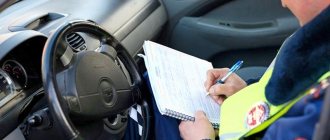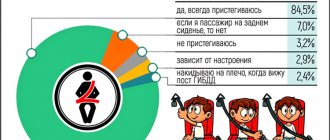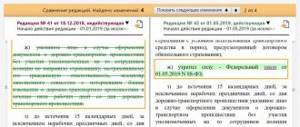What is the fine for a pedestrian?
For 2021, it ranges from 1,500 to 2,500 rubles under Article 12.18 of the Administrative Code. Exactly what amount will be assigned as a sanction depends on aggravating and mitigating circumstances, and this is decided by the inspector who issues the fine. Simply put, if you admit guilt, repent of what you did, and haven’t been fined for crossing a zebra crossing for about a year before, then a minimum amount should be imposed. If failure to allow a pedestrian to pass led to an accident, and you are a repeat offender for this violation, then the maximum level of this fine may be assigned.
If a traffic violation is recorded on an auto-recording camera, then, as a rule, the maximum amount of punishment for this is assigned.
The good news is that you can appeal a fine for not allowing a pedestrian to pass at a crossing not only to cancel the penalty, but to reduce the amount.
We have a more detailed article about the penalty for this in 2021.
The above sanction may be imposed in the following cases:
- if you do not let a pedestrian pass at an unregulated pedestrian crossing (when the driver is obliged to stop if he sees pedestrians entering or crossing the roadway) - violation of clause 14.1 of the traffic rules,
- if, when turning right or left, you do not allow this category of road users to pass (13.1 Traffic Regulations),
- if you do not give the tram passengers the opportunity to get to it when the tram stops (14.6 traffic rules),
- if you do not give way to people with a white cane anywhere on the road (not only at the zebra crossing) - 14.5 traffic rules),
- if you do not allow pedestrians to complete crossing the road when the traffic light turns red for them and the light turns green for you, provided that they entered the roadway when the light turned green.
So, the fine has already been issued, what to do next?
Failure to give way to a pedestrian - pay a fine
Despite stricter rules, the number of pedestrians injured at crossings is only growing.
Often both parties are at fault. However, the owner of the vehicle is always responsible.
For this offense, the driver will suffer administrative punishment in accordance with Art. 12.18 Code of Administrative Offenses of the Russian Federation. If you don’t give way at a crossing, you will pay 1,500 rubles .
By the way, from 01/01/2016 you can pay half of the fine within 20 days from the date of the decision.
Fines for hitting a pedestrian:
- For minor damage - confiscation of the certificate for 1-1.5 years or a fine of 2500-5000 rubles.
- Moderate damage - up to 20,000 rubles. or deprivation of rights for 1.5-2 years.
- If a pedestrian is seriously injured or killed, penalties up to and including imprisonment apply.
In addition, the victim has the right to demand compensation for damage to health.
At the trial of the collision, the following factors will also be taken into account:
- driver's condition;
- whether he helped the victim or fled the scene.
Deadlines for appeal
In general cases, the deadline for filing a complaint against any traffic police fines is 10 days from the date of receipt of a copy of the decision:
- from the day the inspector handed you a copy of the decision,
- from the day you took it out of the mailbox, if the fine was issued by an automatic recording camera.
Very often, motorists confuse the decree with the protocol. The first is a fine in its formal form. The latter is not appealable, but only means that the fine has not yet been imposed, but there will be a hearing at the traffic police in your presence, where you must be invited, and as a result of the analysis they will make such a decision.
If 10 days are missed, then along with the complaint you can submit a free-form petition to restore the deadlines, but there must be good reasons for this.
How to appeal a fine: step-by-step instructions
Appealing a fine is allowed directly through the traffic police or in court.
In the first case, the procedure looks like this:
- Drawing up an application. It is issued by the car owner independently.
- Submitting an application. All documents must be submitted to the traffic police department whose decision is being challenged.
- Receiving a response from the manager. The head of the traffic police or another authorized person is given 10 days to consider the complaint, after which he must give a written response to the applicant.
Sample application:
complaints about a fine for not allowing a pedestrian to pass
An appeal against a decision can only be made through a superior inspector. If he is not satisfied with his answer and they do not want to cancel the fine, he should complain to the court.
Legal proceedings follow the same principle described above. The case is considered in one meeting. The claim should be filed with the judicial authority at the address of the defendant.
Deadlines for appeal
Citizens are given 10 calendar days from the date of receipt of the decisions to appeal fines. If a violation is detected by a recording camera, the countdown begins from the date the document was removed from the mailbox.
Documentation
Along with the complaint, copies of the driver’s license, passport and vehicle registration certificate are submitted to the traffic police. Evidence will also be required: witness statements, video camera recordings.
If the fine is issued to a person who was not actually driving, receipts, waybills, train tickets and other documentation indicating the fact that the citizen is in another place may serve as evidence.
How to file a complaint against a decision
Despite the lack of a unified form, the complaint must contain a complete list of data for objective consideration:
- Full name, registration address of the applicant;
- driver's license series and number;
- information about the car: make, color, license plate number;
- details of the resolution, date of preparation;
- the essence of the violation with reference to the article of the Code of Administrative Offenses of the Russian Federation;
- grounds for canceling the fine: the accused driver’s stay in another city, etc.;
- a list of attached documents;
- date and signature.
The complaint is drawn up in two copies. One must be handed over to the traffic police, and the second is returned with a registration mark. If the document is sent by Russian Post, the confirmation is the receipt by the applicant of a notification of delivery to the inspectorate.
Appealing a fine for failing to yield to pedestrians is a labor-intensive process that can take a long time.
Before filing a complaint, you should carefully prepare evidence, otherwise the response to the appeal will be negative. Fines for not allowing a pedestrian to pass. Penalty at a pedestrian crossing
Form and sample complaint about a fine for a pedestrian
There is no strict appeal form for 2021. The complaint is written in free form. However, it must contain certain data:
- number of the resolution, date and time of the fine issued for the pedestrian that you are going to appeal,
- your data, including contact information,
- who issued the decree,
- reasons for canceling the fine,
- your specific requirements for the resolution (cancel, reduce the fine, and so on).
Below you can also submit complaints in DOC format for filling out on a computer or PDF for filling out by hand, as well as a sample for filling out.
- in DOC format.
- in PDF format.
- .
How much will a motorist pay in case of violation?
According to the new law, if a person driving a car does not give way to a pedestrian, he faces a sanction of at least 1,500 rubles
. If the pedestrian himself is at fault, the sanction is applied specifically to him. Suppose he crossed the roadway at a prohibiting traffic light or even in the wrong place. After all, it was the pedestrian who created a danger on the roadway for all participants.
A fine is imposed for obstructing traffic in a pedestrian zone.
:
- Moving under a prohibited signal - 1 thousand rubles, a second identical offense - up to 5 thousand rubles, systematic violations - deprivation of rights for up to 6 months.
- The car stopped in the transition zone and interfered with other traffic participants - 800 rubles.
When a pedestrian is hit by a driver, the offender faces criminal liability. This is the most severe type of punishment for not allowing a pedestrian to pass.
The driver can be fined at the scene of the violation or based on CCTV footage.
Sometimes, the driver is not to blame for hitting a pedestrian. Then you will have to prove your innocence, although it will be quite difficult. There are only two excuses:
- Use the testimony of a person crossing the street. He must agree that he is guilty.
- Use a video recorder. The recording must clearly show that the driver is not at fault.
- If an inspector fines a driver for not allowing a pedestrian to pass, but the pedestrian himself is no longer there, it is impossible to prove the presence of guilt. There is no victim, there is no wrongdoing. The exception is the presence of a video recording from a law enforcement agency.
When a driver fails to yield to a pedestrian and runs a red light, he must be prepared to pay a fine. Nowadays, many crossings have special surveillance cameras installed. Therefore, if you commit a violation, you can check for a fine on the traffic inspection website. You can make a payment in any of the convenient ways: bank, terminal, electronic wallets and others.
Video: How to avoid a fine for not letting a pedestrian pass
A fine for not allowing a pedestrian to pass at a pedestrian crossing awaits every driver who breaks the law. Even if there was no inspector nearby, the offense may be recorded on a video surveillance camera. The amount of sanctions for such violations has increased significantly. Therefore, it is recommended to be more careful on the roads and not violate traffic rules.
Very often it has quite controversial situations in the specific circumstances of its prescribing. The matter most often becomes a stumbling block because of the essence of creating an obstacle for a pedestrian when he crosses the road. Now the fine for failure to give way to the latter has increased significantly. Corresponding amendments have been prepared to Federal Law No. 301 of October 30, 2017, which comes into force on November 10, 2021. We will consider the subtleties of the changes in the Code of Administrative Offenses, the new fine for a pedestrian of 2,500 rubles and the nuances of such a fine below. You can also follow this article below.
Instructions for appeal
Challenging a fine for not allowing a pedestrian to cross a zebra crossing is quite simple. But success depends on the grounds for appeal - if the punishment was indeed applied illegally, then the fine is also illegal and should be canceled by the person considering the complaint.
But writing a complaint correctly is half the success.
1. Fill out the complaint heading at the very top. The following information is required.
- Where and to whom you submit the application - you can appeal the fine for a pedestrian or to the traffic police - to the unit in which the inspector serves, writing a complaint addressed to his chief; or to the district court at the place where the offense was committed. All this is written on the back of the resolution. If the violation is recorded by an automatic recording camera, then the addressee will also be indicated on the back of the resolution.
- The address of the authority to which you are sending the letter is also indicated in the resolution.
- Your full name, residential address and contact telephone number for communication.
2. Now in the complaint itself you need to indicate the essence of the violation - when, where, under what circumstances, by whom or what (the camera) the decision was made.
Be careful - in the complaint you must write the date and time the traffic police fine was issued, so that it is clear that the appeal deadlines have not been missed, as well as the number of the resolution for identification.
3. Now let's move on to the most important thing - the reasons why you want to appeal the fine. We list them below. And here it is necessary to state the essence of the appeal in a free but understandable form with reference to the norms of legislation. Above in the example, we gave as an example such a basis as the absence of interference with the pedestrian by the driver’s movement, while clause 14.1 requires the driver not to interfere.
4. Now you need to write the demand itself: what do you want with this complaint - cancel the fine for not allowing a pedestrian to pass, reduce it.
5. Finally, we attach a list of documents to the complaint and indicate in the application all the attached documents.
You must include:
- a photocopy of your copy of the resolution,
- a link to a recording on YouTube, if there is a video recorder that proves your innocence (and when challenging a fine for a pedestrian, this is an important argument); pre-upload this video to the specified resource, making access only via a link, if you do not want the video to be publicly available,
- any other documents that could be relevant to the case and serve as an argument for a successful appeal (copy of the sale and purchase agreement, full names of witnesses).
Now all that remains is to sign and the current date, pack it in an envelope, and send it by mail or bring it in person to the traffic police department or TsAFAP that issued the decision, or to the district court at the place where the violation was committed. The letter must be sent by registered mail with a list of attachments.
And don’t worry about missing the appeal deadline due to the long delivery of the letter by mail - the complaint must be filed within 10 days, and you filed it by formally sending the letter, and the date of filing the complaint is considered the date the complaint was sent, indicated in the postal receipt.
In the meantime, here are a few common reasons for contestation.
Traffic rules: give way at a pedestrian crossing
Please note! Changes in the rules also affected the method of giving way. If a driver sees a pedestrian planning to cross the roadway, this does not mean that he should immediately apply the brakes. Previously, in the old version of the rules, the driver was obliged to slow down and stop as soon as the pedestrian stepped onto the zebra crossing.
Now the motorist may not change direction and not stop the vehicle. It is enough to reduce the speed and allow the pedestrian to complete the maneuver.
In addition, the new rules allow the driver to continue driving if his trajectory does not coincide with that of a pedestrian. That is, he can drive in the adjacent lane without interfering with a person’s movement. If this is not possible, then the driver must slow down and let the pedestrian pass.
Attention! Our qualified lawyers will assist you free of charge and around the clock on any issues. Find out more here.
If the roadway has four lanes and the driver is in the leftmost lane and the pedestrian is crossing in the rightmost lane, the motorist can continue driving. Road users do not interfere with each other.
It is important to note that in controversial situations the two-lane rule will apply. This means that there must be two lanes between the car and the pedestrian.
If the light turns green for drivers, they are required to give way to a pedestrian who is completing the crossing. But at the same time, they are not obliged to let through citizens who were on the sidewalk at that moment but planned to cross the road.
Citizens on the sidewalk are not road users. But they become one from the moment they enter the roadway. Drivers are advised to always reduce their speed when a pedestrian crossing is visible. This must be done even if the pedestrian is not visible. He could appear at any minute.
Important! According to the new rules, overtaking at a pedestrian crossing is strictly prohibited. Previously, this could be done if there were no pedestrians at the crossing. Now you can never overtake. There is a fine for this offense.
Not all crossing areas on the road are marked with special signs. But the driver must always give way to blind people who are holding a white cane. It is necessary to give way to pedestrians going to public transport, and to children getting off a bus or car with an emergency signal on and a “transportation of children” sign.
There are no signs installed in the courtyards, but the pedestrian zone has the advantage here.
The rules for crossing the roadway at turns are also inclined towards the pedestrian. The driver must stop even if the person is running a red traffic light. The exception is turning at an intersection.
If a motorist enters an intersection when the traffic light is green, he has the right to complete the maneuver without letting anyone pass. But you need to pay attention to the stop lines. If there are any, the driver must take into account all traffic signals for pedestrians.
Do I need to stop if there are no pedestrians?
If there are no citizens in the pedestrian crossing area, the driver should not stop the vehicle. He has the right to continue moving. Traffic police officers cannot issue a fine if the driver passed a zebra crossing at a time when no one was there, without stopping.
A stop will need to be made if the car in front has stopped in front of a pedestrian crossing. Overtaking is prohibited, so the vehicle must slow down. Overtaking is prohibited even if there are no people on the zebra crossing. The same rule applies to roadways, since according to traffic rules they are considered elements of a pedestrian crossing.
Separate rules apply to scooter drivers and cyclists. They began to operate on November 29, 2014. Now citizens must get off the vehicle and cross the roadway, carrying it next to them. Violation of the rule is punishable by punishment. It is impossible to dispute it.
Watch the video. Was the driver obliged to give way to pedestrians or Article 12.18 of the Code of Administrative Offenses:
On what basis can you appeal?
So, the list of reasons is quite large, we will present the most common ones related specifically to the refusal of pedestrians to pass.
If the pedestrian was not interfered with
Clause 14.1 of the traffic rules, if it is specifically charged with it, requires the driver to give way to a pedestrian who has entered the roadway or is crossing the road along it (at the crossing, of course). Similarly, Article 12.18 of the Code of Administrative Offenses provides for punishment specifically for failure to give way to the road.
Giving way, according to paragraph 1.2 of the Rules, means not creating interference, that is, not forcing a pedestrian to change their trajectory or speed. If this requirement is met, then there is no violation.
For example, a pedestrian has just started crossing on one side of a 6-lane road, and you are moving in a car on the other, like this:
There is no violation in this figure. But the success of appealing a fine for failure to pass here increases significantly if there is a video recorder with evidence that the pedestrian was far from the car at the time of passing the crossing.
Alas, despite the publication of an explanation by the Supreme Court that the protocol alone is not enough to impute a violation to the driver - objective evidence is needed, in practice, the courts and traffic police chiefs, when considering drivers’ complaints, still take the side of the inspectors only on the basis that the latter “has no grounds not to be trusted, because he took the oath.”
Here is an example of when a driver was issued a fine on camera, although there is no evidence that a pedestrian was obstructed (there is no answer to the question of whether the pedestrian changed speed or direction):
In the sample complaint above, we have provided the correct text of the challenge based on the lack of obstruction to a pedestrian.
If the employee has no evidence of guilt
As we have already described above, the lack of video evidence from the driver, according to the law, should not be a reason not to trust him, if the inspector does not have evidence either. But in practice, most often, those reviewing the case trust the employees. But this is not a reason to accept the fine - you need to file a complaint, simply indicating that you did not commit the offense.
Just note that the inspector may still have a video, but he is not obliged to provide it on the road upon request.
The pedestrian must be questioned
This refers to the clause about the absence of a violation due to an uncreated obstacle to a pedestrian. Even if you don't have a dash cam, the inspector is required to review the case fully, which means he is required to interview everyone involved in the situation.
You can request this in writing directly to the inspector on the road, to which he must give a reasoned refusal or still involve the pedestrian as a witness. Just make sure in advance that the pedestrian does not go further about his business by crossing the road.
However, this cannot be a separate basis for a successful appeal, but a violation of procedural norms by the traffic police officer is obvious. To do this, you can attract other witnesses, which can be stated in the protocol or resolution.
If the fine is from the auto-fixation camera
Here the list of reasons is significantly added:
- if it was not you who was driving (according to the law, fines from cameras are issued to the owner of the car), then the driver’s witness statement must be attached to the complaint about the fine for a pedestrian on a zebra crossing, and in this case the fine should be canceled against you and issued to him;
- if the car was sold, then you need to attach a copy of the purchase and sale agreement with the date of the transaction earlier than the traffic violation committed,
- if the resolution does not contain electronic signature data, then this is also a reason for canceling the fine; indicate this in the basis and refer to the norm of Article 29.10 of the Code of Administrative Offenses, as well as the corresponding resolution of the Supreme Court of the Russian Federation,
- if the camera incorrectly identified the license plates of your car, then simply indicate the correct ones in the complaint and attach a copy of the vehicle registration certificate,
- also, when issuing a fine for a pedestrian on an auto-recording camera, a photograph is always attached to a copy of your decision - in this case, you can also appeal the decision on the basis that you have complied with the requirement to give way to a pedestrian at a zebra crossing, if the photo shows that the pedestrian is far from you and the absence interference is obvious to him.
Grounds for appealing a fine
It often happens that drivers are accused of violating traffic rules illegally. The basis for challenging the decision may be the lack of interference for the pedestrian, failure to comply with traffic rules, and other factors. Let's take a closer look at each of them.
No interference for pedestrians
If a driver is accused of violating clause 14.1 of the traffic rules, according to which he is obliged to let a person enter the road, he should be guided by
There is an uncontrolled crossing on a six-lane road. A person moves along it from the left, and a car from the right edge. In such a situation, the car owner will not create any obstacles, but the traffic police may regard this as a violation and issue a report.
You can try to talk to the pedestrian himself and find out whether the car interfered with his movement. However, as a rule, the traffic police do not want to listen to drivers and immediately draw up reports, so you have to appeal in any case.
Drawing up a protocol without witnesses
According to the law, all reports on traffic violations must be drawn up in the presence of two witnesses. If the driver denies his guilt, but the traffic police refuse to involve outsiders, you can put a signature on the document indicating disagreement with the accusation and appeal it in the future.
Another option is to involve the pedestrian himself to testify. He can participate as a witness, but even his denial of the driver’s guilt is often not taken into account by inspectors.
If a violation is detected by a video camera
Nowadays, in most cities, cameras are installed that allow recording almost all types of violations, including failure to pass a pedestrian.
Dear reader! Didn't receive an answer to your question? Our expert lawyers work for you. It's absolutely free!
- Moscow ext 152
- St. Petersburg ext 152
- All regions ext 132 (Toll free)
There are several possible scenarios here:
- At the time of the violation, it was not the owner of the car who was driving, but another person. All decisions are always sent to the registration addresses of car owners. If on the day of the violation it was not the owner who was driving, but his acquaintance, the latter can pay the fine himself. The second option is for both of them to contact the traffic police with an explanation, and then the resolution will be issued specifically to the violator.
- The car has been sold, but the fines keep coming. Here, the former owner just needs to contact the traffic police with a purchase and sale agreement, which will indicate the date of the transaction. He also has the right to deregister the car, and then the unscrupulous buyer will have problems.
- There is no decryption of the EDS (electronic digital signature) on the resolution. According to Art. 29.10 of the Code of Administrative Offenses of the Russian Federation, the document must contain it without fail. If there is no transcript or signature itself, this is interpreted as a procedural violation, and the document must be canceled;
- The decree contains incorrect vehicle registration details. In some cases, the traffic police confuse the data, and as a result, another person receives fines for a violation. Here it is enough to present the STS inspector and submit an application to cancel the decision.
If a pedestrian jumps into the road
Not only drivers, but also pedestrians must follow traffic rules. Before starting to move along the roadway, they must make sure that all cars have time to stop and let them pass.
In 80% of cases, people cross the road without looking, and drivers may not have time to react to their maneuvers. If a person jumped onto the roadway unexpectedly (for example, ran across, or walked along the sidewalk and suddenly changed his trajectory towards the road), the driver has the right to challenge the fine by presenting video evidence. Witness testimony confirming his innocence will also not be superfluous.
Is it possible to appeal a pedestrian ticket online?
By law no.
Update from 11/08/2018. In connection with the decision of the Supreme Court, an information footnote appeared on the traffic police website stating that appeals against fines through appeals are not carried out.
The fact is that the legislation of 2021 does not provide for filing a complaint online via the Internet, because one of the main attributes of the complaint should be the signature of the person involved - that is, yours. Thus, it is possible to challenge a fine for a pedestrian at a zebra crossing only if the applicant has an enhanced digital signature.
But with a high degree of probability, the complaint will be considered if you submit it through the online reception of the official website of the traffic police. Just write there what you would write in the form and sample complaint above.
When can you challenge?
Not everyone knows how to challenge a traffic police fine for a pedestrian. To do this, you need to understand the general legislative nuances.
It is possible to challenge a fine for not allowing a pedestrian to pass in the following cases:
- There are dash cam recordings with a clear picture that the previous car did not stop. It will be problematic to challenge a penalty for not allowing a person to cross the road;
- a pedestrian crossing was crossed by a cyclist or a person on a motorcycle;
- there is video evidence or witnesses who can confirm poor visibility on the road at a given time of day and at the indicated place of pedestrian special markings.
It is possible to challenge a fine for failure to allow a pedestrian to pass, but it may take the driver some time.










